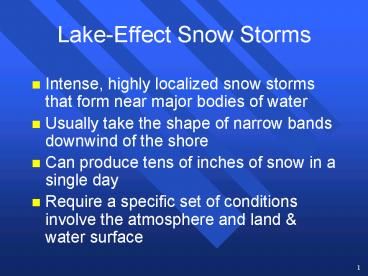LakeEffect Snow Storms - PowerPoint PPT Presentation
1 / 46
Title:
LakeEffect Snow Storms
Description:
Intense, highly localized snow storms that form near major bodies of water ... 37.9 inches at the Buffalo Airport in 24 h. 11. 12. The Lake-Effect 'Season' 13 ... – PowerPoint PPT presentation
Number of Views:33
Avg rating:3.0/5.0
Title: LakeEffect Snow Storms
1
Lake-Effect Snow Storms
- Intense, highly localized snow storms that form
near major bodies of water - Usually take the shape of narrow bands downwind
of the shore - Can produce tens of inches of snow in a single
day - Require a specific set of conditions involve the
atmosphere and land water surface
2
A Lake-Effect Snow Storm on Satellite
3
A Lake-Effect Snow Storm on Radar
4
A Lake-Effect Snow Storm on Radar
5
Geographic Preferences
6
Geographic Preferences
7
Geographic Preferences
8
Great Lakes Snowfall Climatology
9
Zooming In The Average Annual Snowfall (inches)
Over the Eastern Great Lakes
10
Record Event
37.9 inches at the Buffalo Airport in 24 h
11
(No Transcript)
12
The Lake-Effect Season
13
Basic Concepts of Formation
14
Basic Concepts of Formation
The atmosphere upwind of thelake is
characterized by a verystrong temperature
inversion, witharctic air near the ground. Air
isblowing from the land toward thewater.
15
Basic Concepts of Formation
16
Basic Concepts of Formation
17
Basic Concepts of Formation
The warm water provides thermalenergy and
moisture to theoverlying cold air
rememberthat thermal energy transportis from
warm to cold. The warmair rises to form clouds.
Note thatit also raises the height of
thecapping inversion.
18
Basic Concepts of Formation
19
Basic Concepts of Formation
Note how the inversion has risen in altitude and
thelower-levels of the atmosphere have moistened.
20
Basic Concepts of Formation
21
Basic Concepts of Formation
The rising air condenses to formprecipitation,
and snow fallsdownwind of the shore line.
Thegreater the air-water temperaturecontrast,
the heavier the snowfall
22
Formation of Bands
Looking down the wind direction, from west
toeast, the clouds tend to form into
bands, usually oriented parallel to the long axis
of the lake
2
1
23
A Lake-Effect Snow Storm on Radar
1
2
24
Formation of Bands
Note the rising and sinking motion
25
Formation of Bands
Clouds are suppressed in between bands
26
Formation of Bands
27
Ingredient 1 for Formation
- Sufficient temperature difference between the
lake surface and overlying air - Represents a measure of instability, similar to
the lifted index in the context of thunderstorms - At least 13 C difference between water and 850 mb
- This is approximately the dry adiabatic lapse
rate between 1000 mb (surface) and 850 mb
28
The Temperature Difference on a Thermodynamic
Diagram
29
Water Temperatures are Available
30
The State of the Water and Land is Critical
31
The State of the Water and Land is Critical
32
Ingredient 2 for Formation
- Sufficiently deep cold air mass at the surface
- One of the most important aspects when
considering intensity - Inversion heights lt 3000 ft preclude heavy
lake-effect snows - Inversion heights gt 7500 ft strongly support
heavy lake-effect snows - In some cases, an inversion may not be present or
obvious
33
Wheres the Beef?
34
Ingredient 3 for Formation
- Directional wind shear
- Small amounts of directional wind change with
height (lt 30 degrees) below the inversion favors
horizontal roll convection - Highly sheared environments (gt 60 degrees)
disrupt and diminish the efficiency of rolls,
leading only to flurries
35
Ingredient 4 for Formation
- Adequate Fetch
- Fetch is the distance traveled by air over water
- Long fetch promotes more heating of the air and a
higher inversion - A minimum fetch of 100 miles is needed for
significant lake-effect snow - Flow over multiple lakes can help
36
Demonstration of Fetch
37
Ingredient 5 for Formation
- Sufficiently moist upstream air
- RH gt 70 below the inversion favors heavy
lake-effect snow - RH lt 50 usually means little snow
- Often upstream RH is the factor that kills
potentially heavy lake-effect events
38
Orographic Lift Can Make a HUGE Difference!
39
Effect of Orography
40
Shoreline Orientation Can Make a HUGE Difference!
41
Shoreline Orientation Can Make a HUGE Difference!
Change in surfacefriction as air passes from
land to water causesconvergence in theregion
shown by a
42
Shoreline Orientation Can Make a HUGE Difference!
First bandforms in theconvergenceregion.
Notedivergence- nearby
43
Shoreline Orientation Can Make a HUGE Difference!
44
This Theory in Action
45
This Theory in Action
46
If Atmosphere is SufficientlyUnstable,
Thundersnowstorms Can Form































